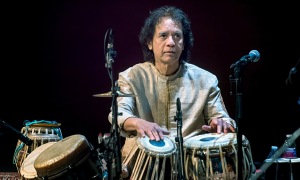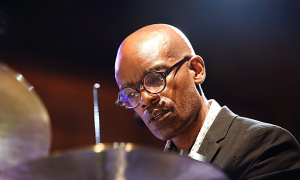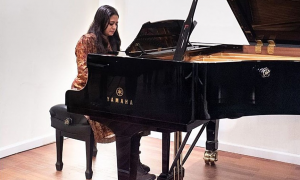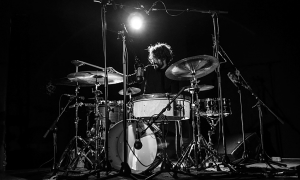Home » Jazz Articles » Under the Radar » Culture Clubs: A History of the U.S. Jazz Clubs, Part II...
Culture Clubs: A History of the U.S. Jazz Clubs, Part III: Kansas City, Philadelphia, Los Angeles & Beyond

While New Orleans, Chicago, Kansas City and New York City were the incubators of modern jazz, they were by no means the only locations with an appetite for live music. Jazz artists whose point of origin could not sustain multiple venues ventured to locations near and far to practice their trade. In some cases a jazz scene grew up around the migration of musicians, though not always for the long term. Through the first two parts of this series it was evident that there were common denominators that applied to most of the original jazz clubs in the major cities: prohibition and race. The nationwide ban on the manufacture and consumption of alcoholic beverages began in January 1920 and ended in December 1933. It is not a coincidence that many jazz clubs in Chicago, New York and Kansas City were fronts for selling alcohol. The speakeasies, run by various organized crime families, took advantage of the popularity of Jazz Age music and presented that form of entertainment, often as the most thinly veiled approximation of legitimacy. It was a fundamentally unstable platform for promoting jazz and for longevity of clubs. Racial issues were a built-in detriment to permanency as well. Black performers, typically working at the pleasure of white audiences, were the rule rather than the exception. Tensions rose across the range of socio-economic issues from the beginning of the Jazz Age through the 1970s as segregated jazz venues represented a microcosm of the larger social issues. In at least two cases, jazz scenes came to be completely obliterated by their own backstories. Corruption in Kansas City and racial unrest in Philadelphia and Los Angeles destroyed thriving jazz markets—markets that never returned to their previous status.
Kansas City
Kansas City's distinction as a jazz hub in the 1920s and 1930s was aided by simple geography. Traveling musicians from Oklahoma City, Tulsa, Dallas, San Antonio, Omaha and Wichita, saw Kansas City as a stop-over that provided opportunities to play and recruit from a growing talent pool. In contrast to the city's nearest source of talent—New Orleans—the Kansas City style of jazz was a bigger, more complex sound with roots in both rustic regional blues, and the related boogie-woogie form, as well as orchestrated ragtime. Much of this musical development was influenced by those outsiders who lent their own take on the music.
The infamous Kansas City mayor and political boss Tom Pendergast established a dogmatic climate that allowed jazz to grow during Prohibition. For more than a decade beginning in 1925 and ending with his arrest for tax fraud in 1938, Pendergast exercised a sprawling control of the city and allowed vice to run rampant. The speakeasies and cabarets where Kansas City jazz developed, were the domain of mobsters and corrupt politicians, just as they often were in Chicago and New York.
More than one-hundred nightclubs and dozens of dance halls existed in 1930s Kansas City. The historic jazz district at 18th and Vine was densely populated with theatres whose programs revolved around jazz. The Gem, Panama, Lincoln and Boone were originally ragtime venues that evolved with new musical developments. Prior to joining the Benny Moten Band, Count Basie played organ at the Eblon Theater and the Lincoln Theater hosted Saturday shows with live broadcasts. The "Vine Street Varieties," as they were called, featured local talent such as Herman Walder, Joe Turner, Pete Johnson and Julia Lee. The Subway Club, El Capitan Club, and the Sunset Club, were among the popular smaller venues of the time.
Not surprisingly, the consequence of Pendergast's downfall was a political reformation that took much of the local jazz scene as collateral damage by the early 1940s. Urban renewal began by plowing under a nineteen block area in the historic district, driving nearby businesses into bankruptcy and leading to years of infrastructure and economic corrosion throughout the district. Though Charlie Parker had left Kansas City for New York by the late 1930s, future stars were still drawn to the city by the halo effect that he had left behind. Sonny Stitt, Dexter Gordon and Miles Davis all made a point of staying and playing in Kansas City when a tour would take them that way.
Advocates for the 18th & Vine Jazz District have seen a slow but well-intentioned revival of the area. The Mutual Musicians' Foundation Building is a historic site that serves the dual purposes of a museum and a performance space. The Blue Room Jazz Club—named after its 1930s predecessor—similarly combines historical artifacts with mostly local jazz performers but also features regular jam sessions and big band shows. Green Lady Lounge self-identifies as the "Venue for Authentic Kansas City Jazz" and the club takes that vision seriously. The focus on the Kansas City tradition is seen in velvet red walls ornamented with vintage oil paintings and 1950s style hanging lamps. The tradition is heard in local talent who play on the main floor stage and in a lower level room, reminiscent of the speakeasies that made the town famous.
Philadelphia
In his book A Prayer for the City (Vintage Books/Random House, 1997), Buzz Bissinger reminds readers that Philadelphia, Pennsylvania is a "city of firsts" amid the metropolitan centers of the U.S. Among those firsts are a hospital, theater, daily newspaper, black newspaper, public school, public bank, magazine, and the first U.S. manufactured piano. Philadelphia was also the first city to produce a substantial home-grown and city-nurtured crop of jazz musicians, many of whom would play a significant role in shaping the future of music. Reminiscent of the stars on Hollywood Boulevard, Philadelphia's Walk of Fame, on Broad Street, features well over one-hundred brass sidewalk plaques that commemorate the city's jazz legends.
In and around the era of the jazz age, Philadelphia produced Benny Golson, Jimmy Bond, and Walter Dickerson, among others. Later arrivals included McCoy Tyner, Bobby Durham, Marilyn Crispell, Marc Copland, Joe Chambers, Uri Caine, Kurt Rosenwinkel, Charles Fambrough, Stanley Clarke and Melody Gardot. Apropos of the "City of Brotherly Love," jazz siblings sprang from the Philadelphia streets. An affinity for Charlie Parker, earned Jimmy Heath the nickname "Little Bird" and in the mid to late 1940s, his band—which included John Coltrane—was a mainstay on the Philadelphia jazz scene. Heath and his brother, the drummer Albert Tootie Heath were natives of the city and shuttled between local venues and New York. Bassist Percy Heath spent his childhood in Philadelphia, later recording more than three-dozen albums with the Modern Jazz Quartet. Brother Albert Tootie Heath, was part of that group and the three brothers worked and recorded as the Heath Brothers from the 1970s into the 1990s. Not the only Philadelphia brothers in jazz, the city gave us Kenny Barron and tenor saxophonist Bill Barron as well as Michael Brecker and Randy Brecker.
As was the case in New Orleans, Chicago and New York, the early venues for jazz were dancehalls and theaters. In Philadelphia, the Academy of Music opened in 1857 as an opera house, hosting Maria Callas, Enrico Caruso, Gustav Mahler, as well as Rachmaninoff, Stravinsky, and Tchaikovsky. But the South Broad Street academy also welcomed many of the great names in jazz such as Duke Ellington, Charlie Parker, Dizzy Gillespie and Coltrane, who called the city home from 1952 until 1958, and then on-and-off until his death in 1967. The Earle Theatre opened in 1924 at 11th and Market Streets. Its enormous stage and a seating capacity of more than twenty-five hundred made the opulent theater a draw for the top names in Big Band music. Benny Goodman, Tommy Dorsey, Glen Miller and Ellington played the Earle, often premiering upcoming or recent recordings. The proliferation of television negatively impacted live shows and led to the closing and demolition of the Earle in 1953.
Billy Krechmer (read his story), a South Jersey reed player with a penchant for Dixieland jazz, opened a modest space called The Jam Session on Ranstead Street in 1938. His business partner, saxophonist Nat Segall, sold out to Krechmer within a year and opened the Downbeat Club which was not related to New York's club of the same name. The Downbeat was—by all accounts—a successful club drawing recognized artists such as Dizzy Gillespie. But Segall was subjected to frequent raids by the Philadelphia police on the grounds of serving alcohol to minors. The local press strongly speculated that the rationale for the raids was actually the police department's disdain for Segall's permitting integrated audiences. Overwhelmed by the barrage of manufactured infractions, Segall closed the Downbeat in 1948. Krechmer, meanwhile, had renamed The Jam Session as Billy Krechmer's Music Room and he enjoyed a very long run, closing in 1966.
Two Broad Street intersections, South and Lombard Streets—were the locations of Pep's Musical Bar and the Showboat respectively. The Showboat was housed in what was once the Douglas Hotel, the location now marked with a plaque designating it as the one time residence of Billie Holiday. Gillespie, Miles Davis, Coltrane, Art Blakey, Cannonball Adderley, Philly Joe Jones, Thelonius Monk and other notable names played the venue that was later renamed as the Bijou Café, with a more cross-genre calendar. Pep's Musical Bar had hosted Nina Simone, Yusef Lateef (who recorded a live album at the club), Nat King Cole, Count Basie, Ellington, Lester Young, Billie Holiday and Monk. At 15th Street and Ridge Avenue The Blue Note featured the Ray Bryant Trio as their house band with occasional appearances from Lester Young, Gillespie, Charlie Parker and Davis, whose quintet with Coltrane, Red Garland, Paul Chambers and Philly Joe Jones appeared at the club in 1956. Watts' Zanzibar (a precursor of the Zanzibar Blue) was a premier jazz site in the 1940s, attracting the top names in the genre. The Columbia Avenue location (now renamed as Cecil B. Moore Avenue) was a centerpiece of the neighborhood known as the "Golden Strip" where there were no fewer than one-dozen thriving jazz clubs. In 1964, three days of rioting, driven by claims of police brutality, destroyed more than two-hundred businesses on and nearby the largely black Columbia Avenue stretch and the jazz scene came to an abrupt, and almost complete end. With top venues such as Crystal Ball, 820 Club, Spider Kelly's, and North West Club now gone, it would be a slow—and somewhat diluted—rebuilding effort to bring a robust jazz scene back to Philadelphia.
Ortlieb's Jazzhaus (also referred to as Ortlieb's Jazzhaus/Brewery) was a converted bowling alley on North Third Street, giving the club a distinctly long footprint. A brewery in its second life, it opened as a jazz venue in 1987. In addition to their "haus band," Ortlieb's was frequented by trumpeter Terell Stafford, pianist Orrin Evans, Farid Barron, Cecil Payne and one-time Gillespie drummer, Mickey Roker. On occasion, a marquee name such as Sonny Rollins or Frank Morgan would drop in for a one-off gig. Closed and demolished in 2010, it reopened at a different Philadelphia location under the name Ortlieb's Lounge in 2012 but jazz was relegated to Tuesday nights. Zanzibar Blue was first housed in a storefront on 11th Street, remaining at that location from 1990 to 1996 at which time it moved into the historic Bellevue Hotel on South Broad Street. In its eleven year run, Zanzibar Blue hosted notable names such as Chick Corea and Chuck Mangione, but more often featured local talent. The Philadelphia Clef Club of Jazz and Performing Arts originated in 1966 through the Musicians' Protective Union Local #274 which was chartered in 1935 and is the oldest Black Musicians' Union in the U.S. "Jazz" was not added to the name until the mid-1990s. By charter, the organization's objectives are largely educational but through workshops, jam sessions, and performances at their own Clef Club, they provide the area with a wealth of live jazz presentations.
The current crop of Philadelphia jazz clubs are often submerged in the broader category of "eateries with music" but that can often be stronger marketing strategy than placing jazz at the top of the bill. The South Kitchen & Jazz Parlor makes its initial gambit as "New takes on Southern fare & deep whiskey list..." but their jazz menu is also substantial. Recent calendar dates include Gerald Veasley, Kim Waters and Marcus Anderson. Chris' Jazz Café on Sansom Street and Paris Bistro & Jazz Café at Germantown Avenue typically offer local jazz talent but on a limited basis. Often, jazz performances are pop-ups in multi-use facilities such as the Ridge Avenue Methodist Church or suburban venues like The Kennett Flash, recently hosting the Charlie Hunter Trio, but the venue is about an hour west of downtown Philadelphia.
Central Avenue, Los Angeles
The rich, early history of the Los Angeles jazz scene is obscured by the city's later legacy, as the birthplace of Cool Jazz and West Coast Jazz but its roots date back to Jelly Roll Morton in 1917. The ragtime pianist's brother-in-law, William Manuel Johnson led The Original Creole Orchestra, the first band to leave New Orleans and tour the U.S. widely. Morton followed Johnson to Los Angeles where he recorded "The Crave," a tango that achieved some success in Hollywood. Similarly, Kid Ory left one of New Orleans' best known bands behind and formed a new group in Los Angeles in 1919.
Central Avenue was the heart of the black population in Los Angeles from 1910 forward. Running from downtown to the south, the district expanding its southern boundary from Watts to Compton as the population grew. The city was one of the most integrated urban centers in the U.S. at the start of the twentieth century but as the population grew, so did racial tensions and discrimination against blacks, Mexicans, Japanese, Indians, and Chinese. Property deeds for both residential and business lots were withheld from blacks outside the district. Despite the prejudicial strains, the Central Avenue corridor provided a well-established enclave for black businesses, residents and entertainment, at least for a time.
The heart of the Central Avenue jazz scene was the Dunbar Hotel. Originally the Hotel Somerville, it opened in 1928, providing the growing black middle class with quality lodging and dining. The hotel drew prominent blacks from all professions including Josephine Baker, Joe Louis, Langston Hughes, Thurgood Marshall and W.E.B. DuBois. James Nelson, a Chicago businessman bought the hotel in 1936 after it had already been renamed as the Dunbar. The best-known Central Avenue venue, Club Alabam stood adjacent to the hotel and another prominent club, the Last Word, was directly across the avenue. Within the confines of the Dunbar was another jazz club, the Showboat. In the peak years of jazz on Central Avenue the likes of Lester Young, Charlie Parker, Lionel Hampton, Dexter Gordon, Wardell Gray, Art Pepper and Charles Mingus provided an endless loop of entertainment. Regardless of the particular club musicians were playing, the Dunbar Hotel was typically where they stayed. Jelly Roll Morton, Ella Fitzgerald, Cab Calloway, Louis Armstrong, Duke Ellington, Billie Holiday, Nat King Cole, Lena Horne, Billy Eckstine, and Count Basie were just sampling of those who had signed the guest register. The Dunbar was a popular spot for a sizable number of white Los Angelenos with an affinity for good music and the culture that surrounded it in the Central Avenue District. Wynton Marsalis had once referred to the area as the Los Angeles version of 52nd Street though it owed as much or more to Harlem. Even its prime, the white media all but ignored the phenomena that was taking place on Central Avenue.
There are two historical markers, partially hidden in the overgrown brush in front of the former Dunbar Hotel. It is one of very few vestiges of the district's past. In the 1950s California began developing an extensive network of freeways taking businesses further away from the center of Los Angeles. Consequently, money began drying up for the Central Avenue District as the black population outgrew and left the district, to the extent that they were allowed. In 1964, South Central exploded. Race riots were triggered by the arrest of a black motorist in an incident that would be famously mimicked in the 1990s with the beating of Rodney King. When the rioting ended, Central Avenue resembled a war scene. In six days of rampaging, more than four-thousand troops and two-thousand police were called in; dozens of people were killed and almost one-thousand buildings—businesses and residences—were destroyed. The clubs whose structures physically survived were eventually repurposed but none as jazz venues. In less than a week, almost forty years of jazz had been wiped away.
Cool Jazz & West Coast Jazz in LA
The legacy of Birth of the Cool (Capital, 1957) implies that Miles Davis' 1949 and 1950 sessions were the incubator for "cool," and the recording did popularized the sub-genre among a wider audience. But it was Lester Young's detached, melodic approach, that most influenced the style from his time with Count Basie in the early 1940s. While Davis immediately moved on to hard bop, and later, modal jazz, Young became part of the Norman Granz Los Angeles-based Jazz at the Philharmonic, along with Cool Jazz and West Coast Jazz artists such as the Modern Jazz Quartet, Shelly Manne, Oscar Peterson and Herb Ellis. Despite the links with Young, Davis and a few others, Cool Jazz and West Coast Jazz had a distinctly white profile; Lennie Tristano, Gerry Mulligan, Dave Brubeck and Chet Baker were among the top West Coast Jazz players and were given the greatest access to recording contracts and club dates. With the exception of Brubeck, none were from the west coast, but then the LA link itself was a misnomer. One was just as likely to hear this style of understated jazz being played by reedist John LaPorta, baritone saxophonist Serge Chaloff or trumpeter Herb Pomeroy, all in Boston during the same time period.
A commemorative "manhole" decorates the sidewalk on North Cahuenga, in Hollywood. Here, Shelly's Manne Hole was opened by the drummer in 1960, far from Central Avenue in location and spirit. Shelly Manne's club was the setting for a prominent series of live recordings that included sessions from Bill Evans, Les McCann, Milt Jackson, Cannonball Adderley, Keith Jarrett and others including Manne's own group. The club closed in 1972. The Lighthouse Café on the pier at Hermosa Beach opened to jazz performances in 1949 and was a landmark venue for West Coast jazz through the 1970s. The site of dozens of live recordings, it attracted top-tier artists such as Stan Getz, Chet Baker, The Jazz Crusaders, the Modern Jazz Quartet, Lee Morgan, Joe Henderson and Elvin Jones, all of whom recorded live albums at the club. The Lighthouse Café remains open in 2017 but with jazz sharing the bill with many other genres.
The current jazz scene in Los Angeles may not come close to the city's great jazz years, but the music can be found with some searching. The Jazz Bakery is actually eleven different locations hosting the non-profit's impressive schedule of events. Every day of the week, top artists perform as part of the organization's mission to bring high quality jazz to new audiences in the Los Angeles area. Founded in 1992 by jazz vocalist and educator Ruth Price, who serves as artistic director, a recent stretch of two months featured shows from Alex Cline, Nels Cline, Monty Alexander, Diane Schuur, Ernie Watts, Bill Frisell, Kurt Rosenwinkel, Scott Colley, Brian Blade, Edward Simon and Randy Weston. Herb Alpert's Vibrato Grill, Jazz, & Etc. doesn't have quite the star power of The Jazz Bakery but it offers a steady flow of solid local talent. Victorio's is an Italian restaurant in the San Fernando Valley. It occasionally features jazz artists but does not post an active calendar of events. Casey's Tavern in Canoga Park presents live jazz every Tuesday in the form of a house band that plays swing, bebop, and other traditional jazz. Perch Los Angeles is a fifteenth floor bistro with unobstructed views of downtown Los Angeles. They offer a full calendar of jazz, typically local musicians. The Federal in North Hollywood offers infrequent jazz performances in a calendar that runs the gamut from comedy to performance art.
Boston
Boston had the homegrown potential to be a great jazz city; it was the city that influenced its native sons Nat Hentoff and George Wein to dedicate their lives to jazz but its proximity to New York was a double-edged sword. What New York took in local talent rarely returned to Boston though the New England city benefitted through regular appearances from their New York colleagues. Jazz in Boston came into its own later than some other cities but in the 1940s, Massachusetts Avenue between Huntington and Columbus was a neighborhood of thriving jazz venues. Billie Holiday departed Count Basie's band in 1938, and joined the Artie Shaw Orchestra in Boston weeks later, remaining with Shaw for eight months. Shaw's group played the recently opened Roseland-State Ballroom on Mass Avenue two days each week for an extended period of time and CBS Radio broadcast the live performances throughout New England. Sabby Lewis, Jimmie Lunceford and Duke Ellington played Roseland frequently; Ellington's band featuring top saxophonists Johnny Hodges and Harry Carney. In 1958, with big band music's popularity already well past its prime, Roseland was sold and the venue sharply veered away from jazz.
The Savoy Café was purported to be the most racially integrated club in Boston, a distinction that made it popular with a broader audience but less popular with city officials and police who struggled with racial issues. The club opened in 1935 on Columbus Avenue—a space too small for a dance floor. Roy Haynes started playing at the Savoy as a teenager and "Red" Allen, trombonist J.C. Higginbotham and clarinetist Edmond Hall played the venue. Newport Jazz Festival founder George Wein was a pianist at the club, and on at least one occasion each, "Hot Lips" Page and Sidney Bechet stopped in to perform. As happened with Roseland, the downturn in big band popularity left a gap in club programming. The Savoy Café reverted to Dixieland in the mid-1950s and closed shortly afterward, in 1956.
The Hi-Hat opened in 1937 but didn't feature jazz performances until 1948 at its Mass Avenue and Columbus location. The opening trio had been pulled from a local orchestra and included saxophonist Charlie Mariano and drummer Joe MacDonald. Woody Herman later came to play and Sabby Lewis took advantage of being in close vicinity to Roseland. Around the same time period the club introduced regularly scheduled bebop shows. Popular with the locals, these shows were racially segregated and included Jaki Byard and Nat Pierce. Bostonian, Sonny Stitt played The Hi-Hat as part of an all-local quartet. The club brought in its share of distinguished talent in the 50s including Miles Davis and Thelonius Monk but was burned down in 1959.
The Jazz Workshop opened in 1953, when locals Charlie Mariano and Herb Pomeroy used their music school space for jam sessions. The venue moved from Stuart Street to Huntington Avenue one year later and then to Boylston Street in 1963. Over the years the club played host to an impressive array of jazz artists including Miles Davis, Duke Ellington, Ramsey Lewis, Sonny Rollins, John Coltrane, Herbie Hancock, Ron Carter, Chick Corea, Joe Zawinul, Ahmad Jamal, Stan Getz, Mose Alison, Keith Jarrett and the Sun Ra Arkestra. Another victim of the 1970s economic crisis, the club closed in 1978.
George Wein opened Storyville in 1950 in the Hotel Buckminster and featured regular performances from the likes of Billie Holiday, Ella Fitzgerald, Duke Ellington, Louis Armstrong, Charlie Parker, Gerry Mulligan and Dave Brubeck. In 1953 the club moved to the Copley Square Hotel where it remained until 1959 when it relocated to the Bradford Hotel on Tremont Street. While the club was a platform for the best talent in jazz, Wein's high standards came with a reciprocal cost. The financial strain led to Wein giving up the club in 1960. Wally's Café opened in 1947 at 428 Massachusetts Avenue and moved across the street in 1978 when most of the Mass Avenue clubs were long gone. Joseph Walcott—known as Wally—was the first African American to own a nightclub in the Boston area. Walcott used his venue to successfully mix students from Berklee College of Music, the Boston Conservatory, and the New England Conservatory of Music with veterans of the swing era. Walcott died in 1998, at the age of 101, but his family continues to run the club in the same vein, primarily giving the stage to students. Wally's Café is the oldest surviving jazz venue in Boston and one of the oldest in the U.S.
Today, in the Boston area, there are two, more modern, jazz clubs along the Charles River. The Regattabar opened in 1985 at the Charles Hotel at 1 Bennett Street in Harvard Square and has featured artists such as the Mingus Big Band, Ahmad Jamal and Ron Carter. Scullers opened in 1989 in the Allston neighborhood, just south of Harvard. Along with jazz, the club features world music, cabaret and blues but shows are sporadic. Saxophonist David Sanborn and Cuban trumpeter Arturo Sandoval have played there recently but local talent dominates the calendar. Thelonious Monkfish is at 524 Massachusetts Avenue in Cambridge and mixes sushi with a full calendar of jazz from accomplished, if not well-known, artists. Many, such as Yoko Miwa, Paul Broadnax and Andy Voelker, play extended engagements.
Elsewhere
There were jazz satellites in other U.S. cities, though often modest in scope and longevity. Like Philadelphia, Detroit had a stellar home-grown crop of jazz musicians that went on to national prominence. Elvin, Hank and Thad Jones, Howard McGhee, Tommy Flanagan, Paul Chambers, Yusef Lateef, Milt Jackson, Kenny Burrell, Ron Carter, Frank Foster, Sir Roland Hanna, Donald Byrd, Sonny Stitt, Alice Coltrane, James Carter, Geri Allen, Kenny Garrett and Betty Carter are just a few of the well-known artists to emerge from that city. And like many of the jazz hubs of the 1920s, Detroit was on the cusp of modern jazz from the outset.
At the turn of the twentieth century, the burgeoning auto industry brought large numbers of southerners to Detroit. The forerunners of the big bands were at the vanguard of the city's music industry; one that later gave birth to the Motown sound. Beginning in the era in which Storyville was vanishing from New Orleans, the so-called society bands of Detroit played local events, weddings, parties and dances staying within the boundaries of standard ragtime material. Two black band leaders emerged from that time as having broken new ground. Benjamin Shook experimented with, and perfected, syncopation while Leroy Smith, was playing symphonic jazz of the Paul Whiteman style, in the early stages of the genre. Smith played the Pier Ballroom, a famous dancehall that was part of an amusement complex called Electric Park. Competing for audiences was an all-white society band led by Paul Specht that played the Addison hotel in downtown Detroit.
Big Band Jazz took over Detroit in the mid-1920s with the Jean Goldkette Victor Recording Orchestra and the McKinney's Cotton Pickers being credited with playing a pivotal role in the development of that style. Arranger and saxophonist Don Redman—the uncle of Dewey Redman, and great-uncle of Joshua Redman—came to Detroit in 1927 to lead the already established Cotton Pickers. Under his leadership the band became a significant proponent of big band jazz, first regionally and later, nationally. It was rival band leader, Goldkette, who booked the group into the Graystone Ballroom—a venue that had previously barred black musicians. It was on Goldkette's insistence that the group, once called "William McKinney's Synco Septet," changed their name to the racially offensive ..."Cotton Pickers." The Graystone Ballroom later hosted Duke Ellington on specially reserved blacks-only nights.
Venues like the Chocolate Bar, Plantation Club also hosted cabaret bands, the latter was most known for saxophonist Cecil Lee's seven-piece band. The Melody Club and The Cozy Corner provided work for former large ensemble players. A popular jazz venue, Club Harlem was short-lived and later became The Flame. The business district and entertainment core of African-American residences was known as Paradise Valley and the adjacent south-bordering neighborhood of Black Bottom drew iconic figures such as Billie Holiday, Ella Fitzgerald, and Duke Ellington from the 1920s through the 1950s. The underlying racial tension in the area was capped by a devastating 1943 race riot that resulted in thirty-four deaths and the destruction of much of Paradise Valley.
Baker's Keyboard Lounge has featured jazz since 1939 and is the oldest jazz venue in Michigan. Ella Fitzgerald, Miles Davis, Oscar Peterson, George Shearing, Sarah Vaughn, Joe Williams, Maynard Ferguson, Cab Calloway, Woody Herman, Modern Jazz Quartet, and many others have played the Livernois Avenue location. Cliff Bell's opened in 1935, closing for twenty years in 1985 and reopening in 2005. The club features local and college talent. Similarly, Jazz Café primarily hosts local artists, albeit, in a more opulent setting on Madison Street. Dirty Dog Jazz Café in the affluent waterfront area of Grosse Pointe is a recent entry having been established in 2008. The club typically features sidemen with impressive resumes. Further into the suburbs are Goodnight Gracie in Royal Oak, Black Lotus Brewing Co in Clawson and Live Night Club to the west in Ann Arbor. Each focus on regional artists, occasionally the same acts moving back and forth between venues.
Washington, DC had the Howard Theater at 7th and T Street and The Lincoln Theater at 13th and U Streets. In 1927 the Lincoln became the Lincoln Colonnade and listed well-known artists such as Louis Armstrong and Count Basie, who were also performing at the Howard. San Francisco also offered notable jazz clubs in the 1950s and 1960s including the Jazz Workshop and The Blackhawk where Thelonius Monk recorded Thelonious Monk at the Blackhawk (Riverside, 1960) and The Miles Davis Quintet recorded In Person Friday and Saturday Nights at the Blackhawk, Complete (Columbia, 1961). The celebrated Keystone Korner was a significant venue in the North Beach neighborhood of San Francisco. It opened in 1972 and featured Jessica Williams as the house pianist for a number of years. Sonny Rollins, Art Blakey, Miles Davis, McCoy Tyner, Bill Evans, Betty Carter and Stan Getz added to the club's legendary status before they closed in 1983. Dimitriou's Jazz Alley has been a Seattle mainstay for three decades. Its upcoming calendar includes shows from Abdullah Ibrahim, Terence Blanchard, Chick Corea and Bill Frisell.
There are well over one-hundred and fifty cities or towns in the U.S. that have some type of venue for jazz, and far more suburban locations that fly under the radar. In some cases performances are sporadic, or function as a restaurant hors-d'oeuvre, or a lounge act of questionable identity, but for a genre that Miles Davis pronounced dead more than half a century ago, there seems to be a steady demand for live jazz. In the conclusion of this series, we look at jazz clubs outside the U.S. and talk to Peter Maguire, an Australian journalist turned web developer. Maguire has spent years compiling jazz related databases that offer a global view of clubs, festivals, promoters and more.
Bill Evans At Shelly's Manne-Hole
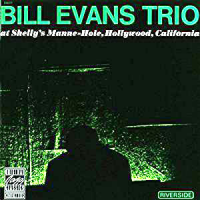 One of Bill Evans last projects for the Riverside label, before departing for Verve, At Shelly's Manne-Hole featured the often under-recognized rhythm section of Chuck Israels on bass and Larry Bunker on drums. Culled from two nights of performances, the album's release was delayed by management snafus at Riverside. Upon its release, the label was less than overjoyed with the recording quality yet there is good reason to recommend this one. The relatively insignificant cadre of Evans' detractors often cite his predictable lyricism and introspection as fatiguing features of his music. For that group, At Shelly's Manne-Hole may be a revelation as we hear a more direct approach from Evans. The opening number, "Isn't It Romantic," and "Swedish Pastry" both demonstrate a willingness to show a bit more aggression. Evans solo on "Blues in F" is alone worth the price.
One of Bill Evans last projects for the Riverside label, before departing for Verve, At Shelly's Manne-Hole featured the often under-recognized rhythm section of Chuck Israels on bass and Larry Bunker on drums. Culled from two nights of performances, the album's release was delayed by management snafus at Riverside. Upon its release, the label was less than overjoyed with the recording quality yet there is good reason to recommend this one. The relatively insignificant cadre of Evans' detractors often cite his predictable lyricism and introspection as fatiguing features of his music. For that group, At Shelly's Manne-Hole may be a revelation as we hear a more direct approach from Evans. The opening number, "Isn't It Romantic," and "Swedish Pastry" both demonstrate a willingness to show a bit more aggression. Evans solo on "Blues in F" is alone worth the price. Wardell Gray's Central Avenue
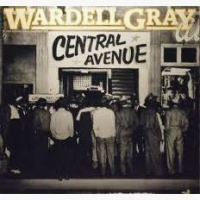 Wardell Gray was a tenor saxophonist of great potential who dabbled in in bebop toward the end of his short, thirty-four year life. Central Avenue is a two-LP compilation of which only a number of pieces were recorded at the Hula Hut Club in Los Angeles in 1949. Gray wrote the majority of the compositions here, with others from Charlie Parker, Buddy Collette, Hampton Hawes and Art Farmer. Farmer, Hawes, Sonny Criss, Clark Terry and Roy Haynes play on several tracks of this Prestige release that has never been offered on CD or digital formats but is available on Spotify.
Wardell Gray was a tenor saxophonist of great potential who dabbled in in bebop toward the end of his short, thirty-four year life. Central Avenue is a two-LP compilation of which only a number of pieces were recorded at the Hula Hut Club in Los Angeles in 1949. Gray wrote the majority of the compositions here, with others from Charlie Parker, Buddy Collette, Hampton Hawes and Art Farmer. Farmer, Hawes, Sonny Criss, Clark Terry and Roy Haynes play on several tracks of this Prestige release that has never been offered on CD or digital formats but is available on Spotify. Yusef Lateef: Live at Pep's
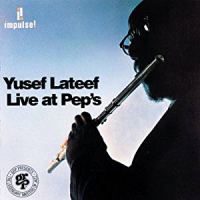 Yusef Lateef, known mostly as a flautist, utilizes the tenor saxophone, oboe, shehnai and argol as well on the 1964 Impulse! release. Lateef is, as usual, the height of classy lyricism and his performance is nicely complemented by Richard Williams on trumpet and Mike Nock on piano. Half of the ten compositions are Lateef originals and the numbers include some fine blues pieces such as "Number 7" and "12 Tone Blues."
Yusef Lateef, known mostly as a flautist, utilizes the tenor saxophone, oboe, shehnai and argol as well on the 1964 Impulse! release. Lateef is, as usual, the height of classy lyricism and his performance is nicely complemented by Richard Williams on trumpet and Mike Nock on piano. Half of the ten compositions are Lateef originals and the numbers include some fine blues pieces such as "Number 7" and "12 Tone Blues." Mary Lou Williams: Live at the Keystone Korner
 An accomplished composer who mentored the likes of Thelonious Monk, Charlie Parker and Miles Davis, Mary Lou Williams' date at Keystone Korner was recorded in 1977 but not released until 2002. It's not for lack of quality as this performance at the legendary San Francisco club is arguably one of pianist Mary Lou Williams' best recordings. On this HighNote Records release Williams offers commanding renditions of "Stormy Weather," "It Ain't Necessarily So" and "St. Louis Blues." Never one for pyrotechnics, she nevertheless crackles through standards and blues, with touches of gospel, putting her stamp on each. Her complex harmonies and percussive style are completely engaging.
An accomplished composer who mentored the likes of Thelonious Monk, Charlie Parker and Miles Davis, Mary Lou Williams' date at Keystone Korner was recorded in 1977 but not released until 2002. It's not for lack of quality as this performance at the legendary San Francisco club is arguably one of pianist Mary Lou Williams' best recordings. On this HighNote Records release Williams offers commanding renditions of "Stormy Weather," "It Ain't Necessarily So" and "St. Louis Blues." Never one for pyrotechnics, she nevertheless crackles through standards and blues, with touches of gospel, putting her stamp on each. Her complex harmonies and percussive style are completely engaging. Photo: Shades of L.A. Collection, Los Angeles Public Library. Ringside at Club Albam, ca. 1945
< Previous
Live from Stern Grove Festival
Comments
Tags
Under the Radar
Karl Ackermann
Benny Moten
Count Basie
Joe Turner
Charlie Parker
Sonny Stitt
Dexter Gordon
Miles Davis
benny golson
Walter Dickerson
McCoy Tyner
Marilyn Crispell
Marc Copland
Joe Chambers
Uri Caine
Charles Fambrough
Stanley Clarke
Melody Gardot
Jimmy Heath
John Coltrane
Albert Heath
Percy Heath
Kenny Barron
Bill Barron
Michael Brecker
randy brecker
duke ellington
Dizzy Gillespie
Benny Goodman
Tommy Dorsey
Glen Miller
Billie Holiday
Art Blakey
Cannonball Adderly
Philly Joe Jones
Thelonius Monk
Nina Simone
Yusef Lateef
Nat King Cole
Lester Young
Ray Bryant
Red Garland
Paul Chambers
Terell Stafford
Orrin Evans
Cecil Payne
Sonny Rollins
Frank Morgan
Chick Corea
Chuck Mangione
Gerald Veasley
Charlie Hunter
Jelly Roll Morton
Kid Ory
Lionel Hampton
Wardell Gray
Art Pepper
Charles Mingus
Ella Fitzgerald
Cab Calloway
Louis Armstrong
Lena Horne
Billy Eckstein
wynton marsalis
Modern Jazz Quartet
Shelly Manne
oscar peterson
Herb Ellis
Lennie Tristano
Gerry Mulligan
Dave Brubeck
Chet Baker
John LaPorta
Serge Chaloff
Herb Pomeroy
Les McCann
Milt Jackson
Cannonball Adderley
Keith Jarrett
The Jazz Crusaders
Joe Henderson
Elvin Jones
Alex Cline
Nels Cline
Monty Alexander
Diane Schuur
ernie watts
Bill Frisell
Kurt Rosenwinkel
Scott Colley
Brian Blade
Edward Simon
Randy Weston
Herb Alpert
Artie Shaw
Johnny Hodges
Harry Carney
Roy Haynes
Sidney Bechet
Charlie Mariano
Jaki Byard
Nat Pierce
Mingus Big Band
David Sanborn
arturo sandoval
Frank Foster
Roland Hanna
Donald Byrd
Alice Coltrane
James Carter
Geri Allen
Kenny Garrett
Betty Carter
Dewey Redman
Joshua Redman
George Shearing
Joe Williams
Woody Herman
Jessica Williams
abdullah ibrahim
Terence Blanchard
Chuck Israels
Larry Bunker
For the Love of Jazz
 All About Jazz has been a pillar of jazz since 1995, championing it as an art form and, more importantly, supporting the musicians who create it. Our enduring commitment has made "AAJ" one of the most culturally important websites of its kind, read by hundreds of thousands of fans, musicians and industry figures every month.
All About Jazz has been a pillar of jazz since 1995, championing it as an art form and, more importantly, supporting the musicians who create it. Our enduring commitment has made "AAJ" one of the most culturally important websites of its kind, read by hundreds of thousands of fans, musicians and industry figures every month.





